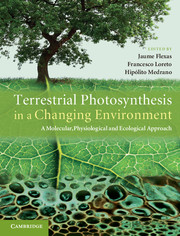 Terrestrial Photosynthesis in a Changing Environment
Terrestrial Photosynthesis in a Changing Environment Book contents
- Frontmatter
- Contents
- List of contributors
- Preface
- Acknowledgements
- List of abbreviations
- 1 Terrestrial photosynthesis in a changing environment
- Part I Photosynthesis
- Part II Measuring photosynthesis
- Part III Photosynthetic response to single environmental factors
- Part IV Photosynthesis in time
- Part V Photosynthesis in space
- 26 Whole-plant photosynthesis: potentials, limitations and physiological and structural controls
- 27 Ecophysiology of photosynthesis in the tropics
- 28 Ecophysiology of photosynthesis in desert ecosystems
- 29 Ecophysiology of photosynthesis in semi-arid environments
- 30 Ecophysiology of photosynthesis in temperate forests
- 31 Ecophysiology of photosynthesis in boreal, arctic and alpine ecosystems
- 32 Crop photosynthesis
- Part VI Photosynthesis in a global context
- References
- Index
28 - Ecophysiology of photosynthesis in desert ecosystems
Published online by Cambridge University Press: 05 March 2013
- Frontmatter
- Contents
- List of contributors
- Preface
- Acknowledgements
- List of abbreviations
- 1 Terrestrial photosynthesis in a changing environment
- Part I Photosynthesis
- Part II Measuring photosynthesis
- Part III Photosynthetic response to single environmental factors
- Part IV Photosynthesis in time
- Part V Photosynthesis in space
- 26 Whole-plant photosynthesis: potentials, limitations and physiological and structural controls
- 27 Ecophysiology of photosynthesis in the tropics
- 28 Ecophysiology of photosynthesis in desert ecosystems
- 29 Ecophysiology of photosynthesis in semi-arid environments
- 30 Ecophysiology of photosynthesis in temperate forests
- 31 Ecophysiology of photosynthesis in boreal, arctic and alpine ecosystems
- 32 Crop photosynthesis
- Part VI Photosynthesis in a global context
- References
- Index
Summary
Introduction
One of the most interesting aspects of desert-plant ecophysiology is the complex nature of adaptations that allow them not only to survive but also to reproduce and maintain their populations under the extreme conditions of environmental stress present in these ecosystems. Of course, deserts are defined by having limited rainfall (typically <250 mm annually) and thus produce significant climatic drought stress, but the seasonality of rainfall patterns and thus drought varies across desert regions, as do the plant growth forms that dominate the landscape (Fig. 28.1).
Terrestrial vascular plants, in any environment where water is limiting for growth, face a dilemma. Their uptake of CO2 from the atmosphere can only occur by opening stomata on their exposed organs regulated by guard cells. However, at the same time that stomata are open and CO2 diffuses into green tissues for photosynthesis, water vapour diffuses out of the plant into the surrounding, drier air. A plant’s strategy can be to reduce transpirational loss by keeping its stomata closed and thereby lose no water vapour, but during that time it also fixes no atmospheric CO2 and thus cannot produce new sugars necessary for growth and respiration. Obviously then, stomata must be opened for photosynthesis to occur but at a significant cost to water levels. The hotter and drier the outside air, the more rapid will be the rate of water-vapour loss from plant tissues.
- Type
- Chapter
- Information
- Terrestrial Photosynthesis in a Changing EnvironmentA Molecular, Physiological, and Ecological Approach, pp. 435 - 447Publisher: Cambridge University PressPrint publication year: 2012
- 3
- Cited by


